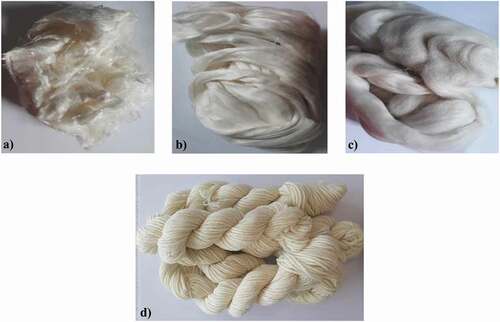ABSTRACT
To refute the global catastrophe owing to emissions and effluents from the textile wet processing units, with sustainability at fore, the research herein performs the processing of natural fibers with herbal materials for coloration and to add functionality. Biodegradable fibers bamboo, banana, and merino wool were contemplatively considered for treatment with surplus plant-based materials, namely, mango ginger, alkanet, henna, cloves, munro, chilly, birch, goldenrod, poplar, and walnut. An organic process was developed for the extraction and application of natural biomaterials on natural fibers for sustainable outcomes.
The dissolved oxygen (DO) level and oxidation-potential level (ORP) were highest with cloves at 7.91 mg/l and 84.0 mV, respectively. The maximum K/s values obtained for mango ginger, cloves, and henna were 26.43, 23.23, and 28.53, respectively. The wash fastness ratings and the lightfastness ratings were best obtained with merino wool yarns treated with cloves. The ATR-FTIR demonstrated cloves and merino wool yarns treated with cloves as the most condensed in functional groups, namely, alcohol O-H bonds, C = C aromatic carbonyl group, and carbon to nitrogen triple bonds followed by mango ginger and henna. Evaluation of functional properties such as anti-microbial will be carried out further.
摘要
为了反驳由于纺织湿处理装置排放物和废水造成的全球灾难, 本研究以可持续性为出发点, 采用草药材料对天然纤维进行染色处理, 并增加功能性. 可生物降解纤维竹子、香蕉和美利奴羊毛被考虑用于处理剩余的植物基材料, 即芒果姜、烷酮、指甲花、丁香、芒罗、辣椒、桦树、黄花、杨树和核桃. 开发了一种有机工艺, 用于在天然纤维上提取和应用天然生物材料, 以实现可持续发展. 丁香的溶解氧 (DO) 水平和氧化电位 (ORP) 最高, 分别为7.91mg/l和84.0 mV. 芒果姜、丁香和指甲花的最大K/s值分别为26.43、23.23和28.53。经丁香处理的美利奴羊毛纱线的耐洗牢度和耐光牢度最好. ATR-FTIR表明, 丁香和美利奴羊毛纱线经丁香处理后, 其官能团最为浓缩, 即醇O-H键、C=C芳香羰基和碳氮三键, 其次是芒果姜和指甲花. 将进一步评估功能特性, 如抗微生物.
Introduction
The human health implications from the textile industry have been detrimental wherein the clothing being second skin is exposed to textile dyes and additives that are cytotoxic, carcinogenic, genotoxic, and mutagenic causing DNA damage (Tang, Lo, and Chi-wai Citation2018). Thus, the European Chemicals Agency (ECHA) and the U.S. Environment Protection Agency (EPA) encourage to develop and utilize plant-based sustainable bio-colors and bio-additives for textile processing (Greenpeace International Citation2013). Likewise, the National Green Tribunal, India, had declared the Bandi river water as unsafe for irrigation purposes, refer (Perfect Sourcing Newsdesk Citation2018). Even more, Greenpeace International investigations on wastewater samples from rivers around textile manufacturing and washing companies in Indonesia and Mexico have revealed the presence of detergents and surfactants 2,4,7,9-tetramethyl-5-decyne-4,7-diol (TMDD), nonylphenol (NP), and nonylphenol ethoxylates (NPEs) (Greenpeace International Citation2013).
Figure 1. Bandi River, Rajasthan, India, colored with water effluent from the surrounding textile dyeing units (Perfect Sourcing Newsdesk Citation2018)
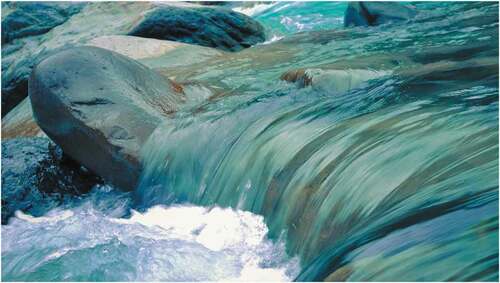
These surfactants persistently contaminate the aquatic environment with hormone-disrupting properties (Greenpeace International Citation2013). Consequently, herbal saponins from Areetha nut and Shikakai would be a sustainable alternative that would benefit the textile manufacturing and washing companies. They are not only biodegradable and renewable sources of surfactants, but also aromatic, soft to the skin, and functionally healing as investigated by Thakker (Thakker Citation2020).
Subsequently, a paradigm shift toward sustainable alternative materials is required wherein it would be essential to propagate alternative fibers, namely, bamboo, banana, hemp, pineapple, sisal, and others. Implement ecological technologies, namely, plasma surface modifications and digital print technology for sustainable conclusions. Embrace plant-based renewable, biodegradable sources of colors and additives also cultivate a green chemistry approach (Fletcher Citation2008) (The United States Environmental Protection Agency Citation2017). The research complies with the same for sustainable outcomes; therefore, alternative fibers bamboo, banana, and the finest ecological fiber merino wool are utilized for research experimentations.
Bamboo is a natural cellulosic fiber obtained from Bambusoideae (Bamboo grass), shown in . The bamboo plant is a perennial plant and regrows every 2–3 years. Bamboo has strong roots and requires no pesticides as it is anti-bacterial. Bamboo is a strong plant fiber with good air permeability, UV protection ability, and moisture absorbency. Also, the biomass from bamboo can be upcycled for biofuels and as raw material for other textile purposes (Bahrum and Thompson Citation2018).
Figure 2. Bambusoideae (Bamboo grass) for obtaining bamboo fibers (Harvest returns Citation2019)
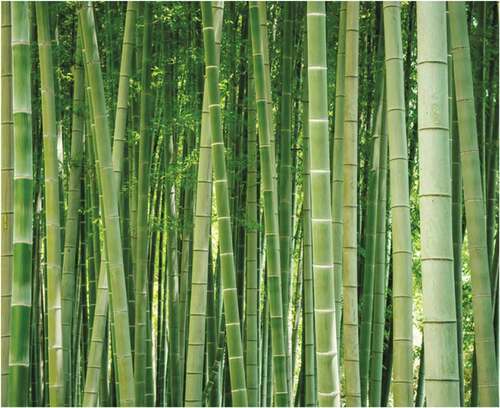
Bamboo fibers were dyed with green tea extracts by Satindar, Chattopadhyay, and Varinder. Brown shades obtained on banana fibers had very good wash and light fastness properties. However, the study performed pre-mordanting with fossil-based copper sulfate as mordant, consequently depleting the mineral ores and therefore a relevant ecological approach would be vital for sustainable inferences. Green tea was extracted by boiling for 1 hour in solvents composed of acetone, acetonitrile, and methanol (Kaur, Chattopadhyay, and Kaur Citation2012), consequently responsible for emissions, effluents, and high on energy demand, which again does not synchronize with the ecological agenda.
Banana is a cellulosic fiber obtained from the Abaca species, Musa textilis, presented in . It grows in 24 months from the first shoots, provides up to 30 stalks of each 15–20 feet in height. Banana fibers are natural, biodegradable, and renewable fibers, and they are inherently strong, shiny, and absorbent (Steele Citation2019).
Figure 3. Abaca species, Musa textilis for obtaining banana fibers (Steele, Stephanie Citation2019)
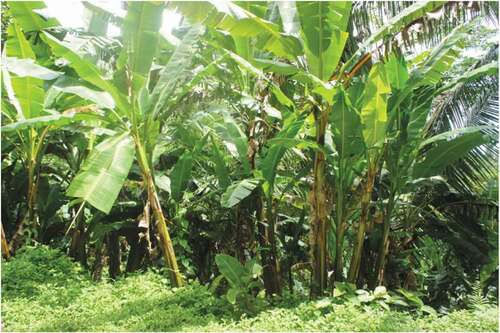
A similar study was instigated wherein authors colored banana fibers with Acacia Catechu implementing synthetic mordants, namely, stannous chloride and ferrous sulfate anticipated to leech non-biodegradable effluents in wastewater dyebath (P; Sharma and Chatterjee Citation2020). Also, banana fibers were treated with alum and colored with marigold, lac, madder, and onion peels. A good wash and light fastness properties were obtained (Teli, Valia, and Mahajan Citation2015). The research would have been more relevant if comparisons were made to in processing banana fibers in natural colors with and without mordant. Also, mineral-derived alum would be demanded to be replaced with plant-based alum by ecologists.
Furthermore, merino wool is 100% natural, biodegradable, and renewable fiber obtained from sheep. It is naturally breathable, soft to the skin, and odor resistant. It is inherently fire and UV resistant, and naturally elastic. shows the carbon cycle in wool. Merino wool is the finest protein fiber with natural carbon, refer to (Australian Wool Innovation Limited Citation2019).
Figure 4. Carbon cycle in wool fibers (Australian Wool Innovation Limited Citation2019)
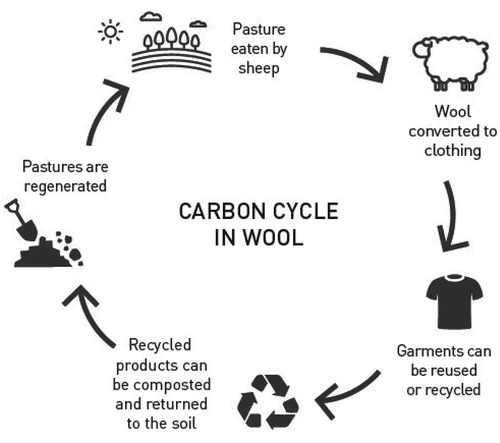
Figure 5. Morphological characteristic of merino wool fibers (Australian Wool Innovation Limited Citation2019)
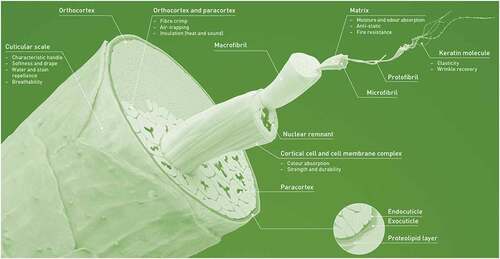
Interestingly, Gong et al. envisaged an ecological approach for coloring merino wool with cinnamon camphora. Sustainable mordants, namely, gallnut, pomegranate peel, arjun bark, chlorophyll extract was utilized (Kang et al. Citation2020). As mentioned in the literature review, merino wool fabrics had been used to heal eczema. It regulates skin moistness thereby alleviating skin itch, redness, and rashes predominantly among people with sensitive dermatology. It is also intrinsically anti-microbial (Australian Wool Innovation Limited Citation2019) (Tissura Citation1998-2020). The characteristic fiber scale structure of the wool fibers is given in (Australian Wool Innovation Limited Citation2019).
Bamboo, banana, and merino wool fibers are naturally ethical and eco-friendly fibers. Also, bamboo, banana, and merino wool fibers are inherently compatible with natural colors. Overall, it is evident that there is a dearth of research and development performed with banana, bamboo, and merino wool fibers in cohesion with plant-based colors.
There is a large volume of published studies investigating and describing the application of natural colors and their functionalities on cotton fabric. Cotton is the king of fibers. There is relatively a small body of literature that is concerned with research experimentation with alternative ecological fibers, namely, bamboo, banana, and merino wool fibers with herbal biomaterials. Therefore, this study identifies and implements traditional and innovative resources of plant-based materials for application on natural fibers such as bamboo, banana, and merino wool.
Research on the treatment of cotton fabric with neem leaf extract has revealed the anti-microbial efficacy of the treated fabric against Staphylococcus aureus and Escherichia coli strains of bacteria. The anti-microbial activity is attributed to the presence of the bioactive component azadirachtin (C35H44O16) intrinsically contained in neem leaves (Vaideki et al. Citation2008).
Similarly, previous research has established a 50:50 combination of wild turmeric and holy basil concoction application on knitted cotton fabrics to be effective against bacterial strains. The bioactive component being germacrene (C15H22O) and eugenol (C10H12O2) inherently present in turmeric and basil, respectively (Chandrasekaran and Senthilkumar Citation2019). In the same vein, the researcher has attempted to evaluate the Ultraviolet Protection factor of cotton fabric treated with green, red, and black tea extracts. The results of this investigation show that UPF was excellent for cotton fabrics treated with green and black tea (Bonet-Aracil et al. Citation2016).
Collectively, these studies outline a critical role of green bioactive chemicals naturally occurring in herbal biomaterials that adhere to the microfibrillar structure of cotton fabrics and eventually interact with the wearer’s skin imparting healing and therapeutic effects. However, such studies remain narrow in focusing on dealing only with cotton fabrics. There remain several aspects of sustainability overlooked in the aforesaid studies. Considering all the evidence, it seems that the ongoing study would be a noteworthy contribution to the field of sustainability, functional textiles, and green chemistry. A holistic multi-disciplinary research approach at the international-individual stratum for global thriveability has been suggested by Thakker for sustainable conclusions (Thakker and Sun Citation2020).
Concurrently, there is an urgent need to address ecological and human health safety from emissions and effluents arising out of the textile processing unit, hence the assigned research is initiated preliminary toward enhancing the color palette with natural colors sustainably. In the next phases of experiments detailed technical, ecological, and functional tests are anticipated. The study is instrumental in achieving the following consequences (Thakker and Sun Citation2020).
To resolve the climate emergency
To combat dermatological, respiratory, and ecological ill effects of fossil-based textiles, for example, 75% of synthetic PET microfibers detected in the fish gut and titanium dioxide and aniline indigo scrutinized as carcinogens.
To meet the 11% market growth demand of natural dyes, pigments and additives predicted for 2025 by enhancing the color palette, substrate applicability, and functionality of natural biomaterials.
To fulfil Sustainable Development Goals (SDG’s) goals on agenda set for 2035.
To meet Regulation, Evaluation, authorization, and restriction of chemicals (REACH) & Environment protection agency (EPA) set the target for 2045 for Scotland and 2050 for the UK of zero emissions and zero effluents.
The present study was envisaged to examine the slow process approach with herbal colors for ecological implications. The study has identified natural biomaterials suitable for applications on bamboo, banana, and merino wool fibers. Conspicuously complex high on energy and water demand machines, methods, and materials are averted in the said study for environmental and pure medicinal effects. A natural progression of this work is to analyze colorimetric values, fastness, and functional properties as accomplished herein. The Life Cycle Assessment (LCA) and anti-microbial test are recommended for future work to establish a greater degree of accuracy on this matter.
Experimental materials and methods
Natural biomaterials
The herbal materials, namely, mango ginger, alkanet, henna, cloves, munro, chilly, birch, goldenrod, poplar, and walnut were sourced from George Weil & Sons Ltd., Surrey, UK, and Sheetal Ayurved Bhandar, India.
Natural fibers specifically bamboo, banana, and merino wool fibers for performing research experiments were sourced from George Weil & Sons Ltd., Surrey, UK. The merino wool yarns for further coloration and testing with selected herbs were procured from the Laughing Hens, Cheshire, UK. The wide-ranging herbal raw materials implemented for research experiments were in different states of a substance such as powdered, partly crushed, and whole. They were further extracted as described ahead in section 2.2.
The significant features of the herbs in this research are described in .
Table 1. Herbal biomaterials in research
Original ready-to-dye a) bamboo, b) banana, c) merino wool fibers, and d) merino wool yarns are illustrated in .
Sustainable extraction of bioactive colors from plants
A 20 grams each of herbal biomaterials mango ginger, alkanet, henna, munro, chilly, birch, goldenrod, poplar, and walnut were soaked in 200 ml of 60°C hot water and left overnight at room temperature of 21°C for the extraction process to complete sustainably.
Sustainable treatment of natural fibers for functionality and coloration with natural biomaterials
The pure extract solution was utilized for treating merino wool, bamboo, and banana fibers. The fibers were soaked in the extract solution for 12 hours at a room temperature of 21°C. The material-to-liquor ratio used was 1:20. The treated fibers were shade dried.
The prospective research preliminary trials and previous studies revealed that natural phytochemicals responsible for functionality and coloration on a textile substrate are preserved at low infusion temperatures. Therefore, greater functional benefits and original color are achieved with minimal heat concoctions of herbal leaves, stems, barks, buds, and flowers. At the same time, being low on energy demand impels sustainable results. (Manimozhi and Kanakarajan Citation2017) (Fletcher Citation2008). illustrate the images of colors obtained. The functionality of herbs on the textile substrate is also detailed in .
Figure 7. The coloration of Bamboo, Banana, and Merino Wool Fibers with a) Mango Ginger, b) Alkanet, and c) Henna
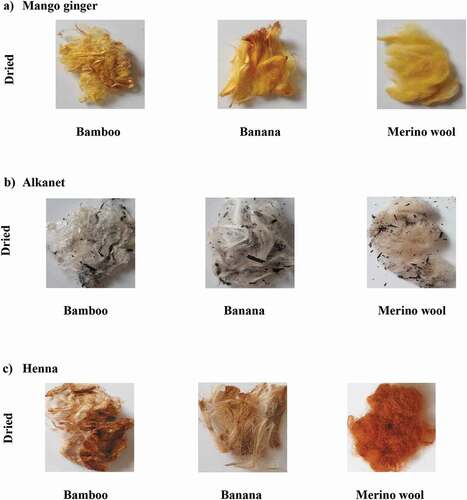
Figure 8. Coloration of Bamboo, Banana, and Merino Wool fibers with a) Munro’s Dessert-Mallow b) Red Chili and c) Silver Birch
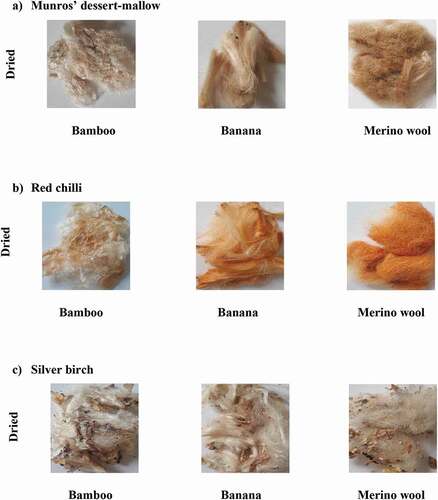
Figure 9. The coloration of Bamboo, Banana, and Merino wool fibers with a) Goldenrod b) Poplar bud c) Walnut leaves, and d) Cloves
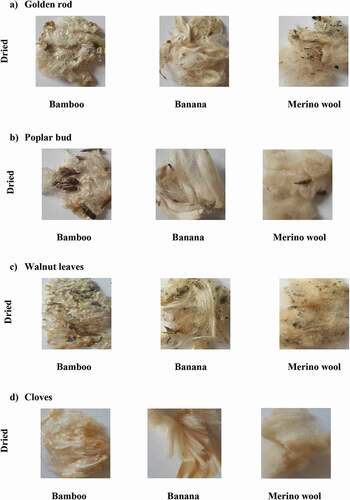
Figure 10. The coloration of merino wool yarns with mango ginger, a) Soaked in extract solution, and b) Dried
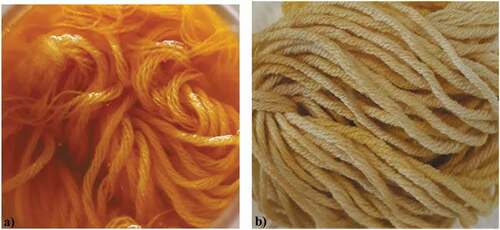
Figure 11. The coloration of merino wool yarns with cloves, a) Soaked in extract solution, and b) Dried
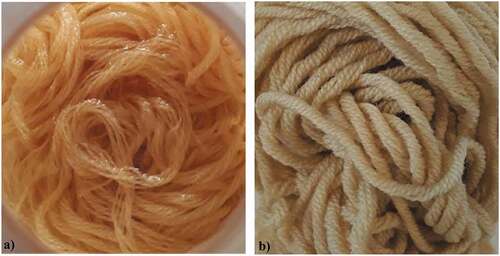
Figure 12. The coloration of merino wool yarns with henna, a) Soaked in extract solution, and b) Dried
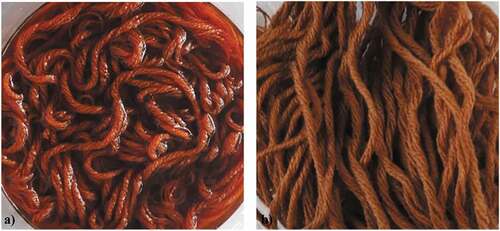
The naturally occurring plant phytochemicals, namely, polyphenolic compounds, for example, quercetin, kaempferol, catechins, and anthocyanins others contained in cloves, green tea, mango turmeric, kattha others responsible for antioxidant, anti-microbial, anti-inflammatory functionality are very sensitive to heat treatment and are expended on boiling. The temperature of the water, which is 30°C to 60°C is most advantageous for maintaining original color stability and functional phytochemical contents. Subsequently, low temperature and overnight extraction or dyeing were concluded to be conducive for the processing of natural fibers with natural herbs (Thakker Citation2020) (Manimozhi and Kanakarajan Citation2017) (Pinheiro et al. Citation2019).
In the same vein, reheating and prolonged heating at a temperature beyond 60°C perish the phytochemicals, for example, 62% of the phenolic acids would be destroyed in 2 minutes at 100°C (aka boiling temperature). The process is simple and clean involving no emissions and effluents. Hence, the ecological devised process concurrently adheres to Sustainable developmental goals (SDGs).
Measurement of color
Three herbs mango ginger, cloves, and henna were selected. The merino wool yarns were further treated with it to facilitate testing procedures. Data color 600, a dual-beam spectrometer was utilized for color measurement. The instrument has an SP2000 monochromator with dual 256 LEDs and a high-resolution holographic grid. The source of light D65 covers the spectral range from 360 nm to 700 nm and has a photometric range of 0% to 200%.
Test of fastness properties
The merino wool yarns were sustainably colored with mango ginger, cloves, and henna was utilized for wash fastness and light fastness testing. The wash fastness test was performed on SDL-ATLAS, M229 Rotawash as per BS EN ISO 105-C06:2010. Lightfastness test was conducted on Turfade, serial number 200/18/1053 as per BS EN ISO 105-B02:2014: Colourfastness to artificial light: Xenon arc fading lamp test.
Characterization of herbal materials by ATR – FTIR
Thermo Scientific™ Nicolet™ iS™ 5, Attenuated Total Reflection – Fourier Transform Infrared Spectroscopy (ATR-FTIR) was implemented for examining the constituent profile of the raw herbal leaves and the treated yarns. For characterization of the peak intensities of functional contents refer. In FTIR, Infrared radiation (IR) is passed through a sample, some of the IR is absorbed by the sample and some of it is transmitted through the sample. The resulting spectrum represents the molecular absorption and transmission, creating a molecular fingerprint of the sample. FTIR is mainly used to measure light absorption of so-called mid-infrared light, light in the wavenumber range of 4,000 to 400 cm−1 (wavelengths 2.5 to 25 µm), to identify and quantify various materials. The raw herbs and merino wool yarns treated with it were analyzed using ATR-FTIR for identifying some meaningful peaks and functional chemical groups.
Dissolved oxygen (DO) and oxidation-reduction potential (ORP) levels of herbal solution
To evaluate the ecological compatibility of the materials and methods, the spent herbal solutions DO and ORP levels were noted with Hanna, HI 9146 microprocessor, dissolved oxygen meter, and the Hanna, HI 8424 pH/mV/°C portable pH meter/ORP meter, respectively.
Dissolved oxygen, oxygen from the atmosphere dissolves in river and lake water, and it is this oxygen that fish and other aquatic animals use to breathe. Dissolved oxygen was measured directly in the water using a calibrated dissolved oxygen sensor. Healthy water should generally have dissolved oxygen concentrations above 6.5–8 mg/l and between about 80–120%. The minimum required is 4 mg/l for optimal survial of marine life in water bodies.
Oxidation-reduction potential, ORP was measured with the help of an ORP meter, which has a range of −2000 to +2000 units expressed in terms of volts (V) or millivolts (mV). A positive (+) ORP means a solution is an oxidizing agent and has more dissolved oxygen. The negative (-) ORP reading means a solution is a reducing agent. The more negative the ORP reading, the more anti-oxidizing a solution is, which means the solution contains less dissolved oxygen as the organics are consuming the oxygen.
Results and Discussion
Color catalog
The research has successfully established color catalogs with 21 herbs on bamboo, banana, and merino wool fibers, however, selected herbs were tested further. The process of extraction and coloration with herbal concoctions is ecological. There are no synthetic or metallic mordants utilized.
As illustrated in the shades obtained on bamboo, banana, and merino wool fibers are markedly in the range of yellow, orange, red, and brown. Bamboo, banana, and merino wool fibers are distinctly aromatic when treated with mango ginger, henna, cinnamon, and cloves. The aroma persists after 30 days of treatment as noticeably aromatic.
The colors obtained with natural biomaterials, namely, mango ginger, cloves, and henna extracts, and on merino wool yarns are demonstrated in , respectively.
The methods of extraction and coloration implemented for research experiments are low on water and energy demands hence sustainable. The spent solution is biodegradable and could be recycled.
Colorimetric values as obtained on Datacolour scan 600
The colorimetric values of merino wool yarns treated with mango ginger, cloves, and henna are illustrated in .
Table 2. Color values obtained of merino wool yarns colored with herbs
The greatest K/S value of 28.53 was obtained on merino wool yarns colored with henna and the minimum K/S value of 23.23 was gained with cloves. The L*, lightness values were maximum with mango ginger where L* is 71.53 and smallest for henna where L* is 30.45. Also, the a* values were greater for henna at 35.25 and the b* value was elevated for mango ginger at 81.80. The merino wool treated with cloves had the minimum a* values of 5.99 and likewise minimum b* value of 34.91. The visual color analysis in daylight would interpret it as lemon yellow, light brown, and dark orange for mango ginger, cloves, and henna, respectively.
Evaluation of Colourfastness properties
The wash fastness properties of merino wool yarns treated with mango ginger, cloves, and henna are illustrated in .
Table 3. Fastness properties of Merino wool yarns treated with mango ginger, cloves, and henna
A fair light fastness was gained on merino wool yarns cured with cloves and henna. The wash fastness rating to color change and staining was very good and excellent for cloves followed by henna and mango ginger subsequently. The herbs and the treated merino wool yarns were condensed in functional phytochemicals that could be applied for disposable facial masks, band-aids, and healing fabrics designed for a specific purpose. The herbal-colored fabrics are categorized as luxury fabrics of today and with its own story to tell it occupies a must-have in every wardrobe.
FTIR Analysis
The FTIR analysis of raw herbs and merino wool yarns treated with mango ginger, cloves, and henna are shown in .
Figure 13. The ATR - FTIR analysis of herbs in research, Mango ginger (MG), Cloves (CL) and Henna (HN)
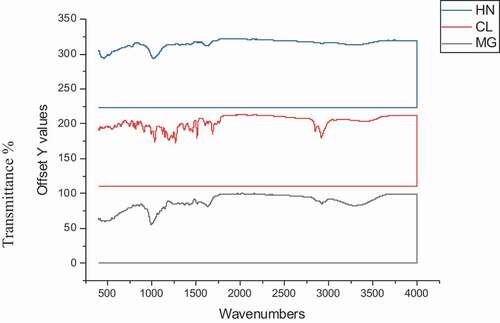
Figure 14. The ATR - FTIR analysis of herbal treated merino wool yarns, Mango ginger (MG), Cloves (CL) and Henna (HN)
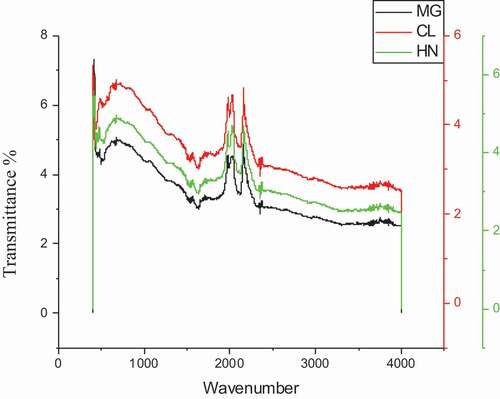
The ATR-FTIR analysis of raw mango ginger herb denotes the presence of strong peaks from 468.82 cm−1 up to 1075.18 cm−1 of wavelength numbers indicating the occurrence of alkenes and aromatic C-H bonds. Likewise, mango ginger-treated merino wool has moderate peaks at 454.49 and 493.67 cm−1 of wavenumbers consisting of alkenes and aromatic C-H bends. Also, the moderated peaks are observed at 1535.55 and 1631.40 cm−1 of wavenumbers for the functional group having C = C bonds.
The ATR-FTIR analysis of raw herb, cloves denoted the presence of aromatic and alkene C-H bands from 555.89 up to 995.13 cm−1 wavenumbers. From 1033.53 cm−1 to 1686.83 cm−1 of wavelength frequency, there indicate the strong presence of single bonds of alkoxy, phenols C-O, C-H, and strong double stretch of aromatic alkene C = C and ester C = O bonds. The strong peaks are denoted at the wavenumber 2849.19 cm−1 and 2917.71 cm−1 indicating the presence of carboxylic acid O-H functional groups and C-H alkane groups of phytochemicals.
Likewise, the merino wool yarns treated with cloves had moderate peaks from 1535.80 to 1729.48 cm−1 of wavenumbers denoting the existence of double bonds of aromatic alkenes C = C and carboxylic acid C = O functional groups. Strong carbon and nitrogen triple bonds are noted at 2116.61 cm−1 wavenumber. Also, moderate peaks of functional groups, alkene C-H bends, and alcohol O-H stretch are indicated from 3623.82 to 3684.42 cm−1 of wavenumbers and beyond.
The ATR-FTIR analysis of raw herb henna denotes the existence of a strong peak at 462.17 cm−1 having the functional groups of alkene and aromatic with C-H bonds. Strong alkoxy and phenol single bonds of C-O are noted at 1023.04 cm−1 of wavenumbers. Subsequently, the merino wool processed with henna herb has moderate peaks in between 1535.80 and 1729.43 cm−1 of wavenumbers having conjugated C = C bonds. The moderate stretch of alcohol O-H and C-H alkenyl is seen from wavenumber 3323.79 cm−1 up to 3730.27 cm−1 of wavenumbers.
Overall, the ATR-FTIR examination concluded cloves and merino wool yarns treated with cloves as the most condensed in functional groups, namely, alcohol OH bonds, C=C aromatic carbonyl group, and carbon to nitrogen triple bonds followed by mango ginger and henna.
represents the essential chemical component, namely, curcumin, eugenol, and lawsone inherently dense in mango ginger, cloves, and henna, respectively. The plant phytochemicals comprising the functional groups impart color and effective properties to the treated substrate.
Evaluation of DO and ORP levels
The dissolved oxygen (DO) and oxidation-reduction potential (ORP) were noted of the spent solution, refer to .
Table 4. DO and ORP after coloration with herbs in research
The ORP values of the surplus solutions were positive after the completion of the coloration of merino wool yarns with herbs in research denoting its ability to be recycled or upscaled. The ORP noted with cloves is 84.0 mV followed by henna at 82.7 mV and the least is noted for mango ginger, which is 36.4 mV.
The DO level of leftover solution after coloration is in the acceptable range for mango ginger and cloves, values being 6.71 mg/l and 7.91 mg/l, respectively. However, the DO level of only 2.59 is noted of the solution spared after the coloration of merino wool yarns with henna. Therefore, it is unsuitable for further consumption or disposal in water bodies. It could be reformed at the waste-water treatment unit.
The pH was noted slightly acidic for mango ginger with the value of 6.22, 5.35 was noted for cloves, and 5.40 for henna after the completion of the coloration process. Therefore, it is suggested to neutralize it at a wastewater treatment plant before upscaling.
Conclusions and implications
The effluent from the fossil-based textile dyes and additives, for example, nonylphenols and phthalates, are consistently leeching into the river streams causing massive damage to aquatic life. They percolate into the bloodstreams and tissues of the workers, leading to hormone disruption and reproduction malfunction. Likewise, emissions of volatile organic compounds, chlorofluorocarbons, and greenhouse gases arising from fabric treatments cause global warming, ozone layer depletion, summer smog, and acid rain, which harm vegetation, aquatic life, and human health. Also, PET-based microfibers are hidden culprits identified in the fish gut and food chain (Greenpeace International Citation2013) (Thakker and Sun Citation2020). Eventually, after performing the research experiment with low on water and energy demand slow process on natural fibers with natural biomaterials the following conclusion can be drawn.
Herbs, namely, mango ginger, alkanet, henna, cloves, munro, chilly, birch, goldenrod, poplar, and walnut are ecologically applied to bamboo, banana, merino wool fibers, and merino wool yarns. Interestingly, no synthetic or natural mordants were applied; consequently, the purity of herbs was maintained.
The devised process is low on water, energy, and solvent demands therefore sustainable. The slow process protects the sensitive phytochemicals therefore original color and optimum functionality could be acquired sustainably.
The merino wool yarns treated with mango ginger, cloves, and henna demonstrated shades in the range of yellow, brown, and orange, respectively.
FTIR analysis identified peak functional groups principally C-H alkenes and aromatics bonds, alkoxy, phenol C-O single bends, carbonyl C = O and C = C conjugated bonds, and alcohol O-H groups in between the wavenumbers from 400 to 4000 cm−1 in herbs and treated merino wool yarns.
The unsafe DO level of the spent solution 2.59 mg/l was noted for henna herb therefore requires to be treated at the wastewater treatment plant before further reuse.
The ORP levels were 36.4, 84.0, and 82.7 mV for mango ginger, cloves, and henna, respectively, hence sustainable.
Good to excellent grayscale ratings of wash fastness properties were acquired of merino wool yarns processed with herbs in research.
Fair lightfastness ratings were gained on blue wool standard with herbs except for mango ginger.
The research conclusions adhere to the projected sustainable outcomes of ‘From nature and back to nature’ aka Eco-Smart fabrics. This study has shown the applicability of natural biomaterials on natural fibers ecologically. One of the most significant findings to emerge from this study is the simple and clean artisanal processing befitting the Sustainable Development Goals (SDGs). These findings have significant implications that would benefit the environment and human health alike. It is imperative to note that the natural plant-based biomaterials for textile applications are nontoxic and safe. They are predominantly synthesized from natural fruits, flowers, stems, leaves, bark grasses, seeds, roots, trees, and berries. The molecules of natural origin are biodegradable, whereas the molecules of synthetic chemicals lack biodegradability and remain back in the environment releasing toxic fumes (Sharma, Singh, and Dighe Citation2018).
Future work
Innovative flora, namely, munro’s dessert-mallow, silver birch, and poplar buds are explored to enhance the color palette and functional aspects prospective with natural fibers and yarns that would further propel the textile market toward sustainability. However, there are significant aspects that require to be addressed with regard to the functionality of fibers and yarns treated with herbs. Therefore, further clinical investigations are recommended to justify the medicinal benefits of herbal-treated textiles. The surplus water left after treatment is biodegradable and therefore zero carbon footprint. However, life cycle analysis would be essential before commercial applications hence suggested for future research and development.
Acknowledgments
The author is grateful to the anonymous funder for sponsoring sustainability-based research for global cause and benefits. The author is grateful to the Heriot-Watt University, Technical Facilities, Scottish Borders Campus, UK.
Disclosure statement
No potential conflict of interest was reported by the author.
References
- Australian Wool Innovation Limited. 2019. Wool fibre facts & benefits. The Woolmark Company. 25 March. Accessed 08 July, 2020. https://www.woolmark.com/about-wool/wool-fibre/.
- Bahrum, R. P., and A. J. Thompson. 2018. Production of natural bamboo fibers-1: Experimental approaches to different processes and analyses. The Textile Institue 109 (10):1381–91. doi:10.1080/00405000.2018.1482639.
- Bonet-Aracil,M. A., Díaz-García, P., Bou-Belda, E., Sebastiá, N., Montoro, A., Rodrigo, R., 2016. UV protection from cotton fabrics dyed with different tea extracts. Dyes and Pigments 134:448–452. doi:10.1016/j.dyepig.2016.07.045.
- Chandrasekaran, K., and M. Senthilkumar. 2019. Synergic anti-bacterial effect of Curcuma aromatica Salisb and Ocimum tenuiflorum Linn herbal extract combinations on treated cotton knitted fabrics against selective bacterial strains. Indian Journal of Fiber & Textile Research 44:344–51.
- Fletcher, K. 2008. Sustainable Fashion and Textiles: Design Journeys, 1:2, 271-274, DOI:10.2752/175693809X469229.
- Harvest returns. 2019. Growing The U.S. Bamboo Investment Market. Harvest returns. 14 June. Accessed 08 July, 2020. https://www.harvestreturns.com/blog/2019/6/14/growing-the-us-bamboo-investment-market.
- International, G. 2013. Toxic threads: Polluting paradise, A story of big brands and water pollution in Indonesia. UK: Greenpeace International. Accessed April 29, 2020. https://storage.googleapis.com/planet4-international-stateless/2013/04/62ec9171-toxic-threads-04.pdf.
- Kang, G., Rather, L. J., Zhou, Q., Wang, W., Li, Q., 2020. Natural dyeing of merino wool fibers with Cinnamomum camphora leaves extract with mordants of biological origin: A greener approach of textile coloration. The Journal of the Textile Institute 111 (7):1038–46. doi:10.1080/00405000.2019.1698228.
- Kaur, S., P.Chattopadhyay, D. and Kaur, V., 2012. Dyeing of Bamboo with Tea as a Natural Dye. Research Journal of Engineering Sciences 1 (4):21–26.
- Manimozhi, R., and S. Kanakarajan. 2017. Natural Dye from Torenia SP Flower for Colouring Silk Yarn using Biomordants-An Ecofriendly Approach. Journal of Chemical and Pharmaceutical Research 9 (11):17–26.
- Pratap S. P., Sharma, D., and Chatterjee, S., 2020. Application of Acacia Catechu Natural Dye on Banana Fiber. Ergonomics International Journal 4 (1):1–8. doi:10.23880/eoij-16000229.
- Perfect Sourcing Newsdesk. 2018. Indian dyeing units find it ‘costlier’ to treat wastewater. Perfectsourcing. 24 October. Accessed 08 July, 2020. https://perfectsourcing.net/news/indian-dyeing-units-find-it-costlier-to-treat-wastewater/.
- Pinheiro, L., Kohan, L., Duarte, L. O., Garavello, M. E. D. P. E., Baruque-Ramos, J., 2019. Biomordants and new alternatives to the sustainable natural fiber dyeings. SN Applied Sciences. 1(11):1356. doi:10.1007/s42452-019-1384-5.
- Sharma, D., Singh, R., and Dighe, B., 2018. Chromatographic study on traditional natural preservatives used for palm leaf manuscripts in India. Restaurator. International Journal for the Preservation of Library and Archival Material 39 (4):249–64. doi:10.1515/res-2018-0005.
- Steele, S. 2019. What is banana fiber and how do you make textiles out of it? Offset Warehouse. 3 June. Accessed 08 July, 2020. https://www.the-sustainable-fashion-collective.com/2019/06/03/what-is-banana-fibre-and-how-do-you-make-textiles-from-it.
- Tang, A. Y., Lo, C. K., and Kan, C. W, 2018. Textile dyes and human health: A systematic and citation network analysis review. Coloration Technology 134 (4):245–57. doi:10.1111/cote.12331.
- Teli, M. D., Valia, S., and Mahajan, J. S., 2015. Dyeing of banana fibre with marigold, lac, madder and onion dyes. Journal of the Textile Association 75:341–44.
- Thakker, A. M. 2020. Sustainable processing of cotton fabrics with plant-based biomaterials Sapindus mukorossi and Acacia concinna for health-care applications. The Journal of Textile Institute. doi:10.1080/00405000.2020.1776537.
- Thakker, A. M., and Sun, D., 2020. Sustainable biomaterials for functional textiles. UK: Heriot-watt University.
- Tissura. 1998-2020. Merino Wool Fabrics. Tissura. Accessed 08 July, 2020. https://tissura.com/articles/merino-wool-fabrics.
- The United States Environmental Protection Agency. 2017. Basics of Green Chemistry. The United States Environmental Protection Agency. 21 March. Accessed 08 July, 2020. https://www.epa.gov/greenchemistry/basics-green-chemistry#twelve.
- Vaideki, K., Jayakumar, S., Rajendran, R., and Thilagavathi, G., 2008. Investigation on the effect of RF air plasma and neem leaf extract treatment on the surface modification and antimicrobial activity of cotton fabric. Applied Surface Science 254 (8):2472–78. doi:10.1016/j.apsusc.2007.09.088.

